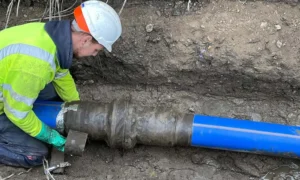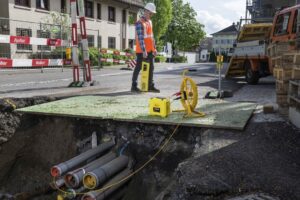Utility Connections:
Ensuring Adequate Capacity for Water and Sewer Services

At Unified Studio Architect, we understand that reliable utility connections are the foundation of any successful development project. Whether it’s a residential, commercial, or mixed-use development, access to critical services such as water and sewer is more than a convenience—it is vital for the functionality, safety, and long-term viability of the site.
In the planning and approval process, one of the most common concerns is ensuring that utility systems can handle the demands of the new development. Insufficient capacity can lead to delays, additional costs, and complications with regulatory compliance. At Unified Studio Architect, we specialize in anticipating and solving these issues to ensure your project moves forward without unnecessary setbacks.
Let’s explore why utility connections are so critical, the common challenges developers face when dealing with capacity, and the strategies we use to mitigate these concerns and keep projects on track.
Why Utility Connections Are Critical
Utility connections, especially those related to water and sewer services, are fundamental to the daily operation and overall sustainability of any building. Access to clean water is essential for drinking, cooking, cleaning, and sanitation. Additionally, a reliable water system is necessary for fire suppression systems, ensuring that the building complies with safety regulations. Without sufficient water pressure and clean water access, the usability and safety of any development are compromised.
Sewer systems are equally important for the safe removal of wastewater, preventing unsanitary conditions and potential health risks. An inadequate sewer system can lead to overflows, contamination, and environmental hazards. Beyond these immediate risks, issues with sewer systems can cause significant regulatory and legal complications, potentially delaying a project for months or even years.
For a development to be successful and meet safety and health standards, it’s essential that both the water and sewer systems have enough capacity to support the volume of usage the project will generate. If the existing infrastructure cannot handle this demand, it can result in water shortages, low pressure, sewer backups, and other issues that could seriously affect the project’s timeline and budget.
Common Issues with Utility Connections

One of the most frequent challenges developers face is ensuring that the existing water and sewer infrastructure can meet the needs of the new development. Below are some of the common issues related to utility capacity that can impact a project:
Existing Infrastructure Limitations: In many cases, the local utility infrastructure was not designed to handle the additional load that new developments bring. This is particularly true in growing areas where the existing water and sewer systems may be outdated or have already reached their maximum capacity. Without proper upgrades, adding new developments can put undue strain on these systems, leading to disruptions and inefficiencies.
Underestimated Water or Sewer Demand: Developers may underestimate the amount of water usage and wastewater a project will generate, leading to an unexpected need for upgrades. This can happen when the initial estimates for a project do not fully account for factors like peak water usage or future growth in the development. When demand exceeds supply, it can result in unplanned expenses and delays.
Lack of Access to Utility Lines: In some cases, a property may not have immediate access to water or sewer lines, requiring significant construction or infrastructure expansion. This issue is more common in rural or undeveloped areas where utility lines are not readily available and must be extended, sometimes over great distances.
Zoning and Permit Issues: Local zoning regulations and building codes can also complicate utility connections. In some areas, zoning laws may restrict the ability to connect to certain utility lines, or local government may require developers to make costly upgrades to the existing infrastructure as part of the permitting process. Navigating these regulations can be complex, adding additional layers of bureaucracy to the project timeline.
How We Mitigate Utility Connection Issues
At Unified Studio Architect, we understand the importance of addressing these potential challenges early in the planning process. Through proactive planning and coordination with local utility providers, we help our clients avoid common pitfalls and ensure their developments have adequate utility services in place from the start. Here’s how we approach these challenges:
Coordinating with Utility Providers for Upgrades: If the existing utility infrastructure lacks the capacity to support the development, we work closely with local utility providers to plan and implement necessary upgrades. This may include increasing the size of water or sewer lines, upgrading pumping stations, or improving treatment plants to handle the additional load. By coordinating these efforts early, we ensure that the project has the necessary capacity to support future demand and avoid delays.
Providing On-Site Septic and Well Systems: In rural or remote areas where municipal services are not available or are difficult to extend, we explore alternative options such as on-site septic systems and well installations. Our team works with local authorities and engineers to design systems that meet all health and safety regulations, ensuring that your development has reliable water and wastewater management solutions even when municipal connections aren’t feasible.
Conducting Comprehensive Utility Studies: Before construction begins, we conduct thorough utility studies to assess the existing infrastructure, estimate future demand, and identify any potential issues. This proactive approach allows us to anticipate problems and address them before they become roadblocks during construction. By working closely with utility providers and engineers, we ensure that your project has the capacity and infrastructure it needs to succeed.
Compliance with Local Codes and Permitting: Local building codes and regulations play a major role in determining the type of utility services required for a project. Our team ensures that all utility connections—whether they’re municipal or on-site—meet the necessary standards for safety, capacity, and environmental compliance. We handle all permitting processes, ensuring that the necessary approvals are in place before construction begins.
Conclusion
At Unified Studio Architect, we are committed to providing our clients with reliable and sustainable utility connections that support the long-term success of their development projects. Whether it’s through working with utility providers to upgrade infrastructure, offering on-site solutions, or conducting comprehensive studies to ensure adequate capacity, our team ensures that your project is prepared to meet all utility needs. With a proactive and collaborative approach, we help developers avoid costly delays, maintain regulatory compliance, and keep their projects on track.
If you’re planning a development and need to ensure adequate utility connections, reach out to Unified Studio Architect today. We’ll work with you to design the best possible infrastructure solutions, ensuring that your project is a success from start to finish. pulvinar dapibus leo.
